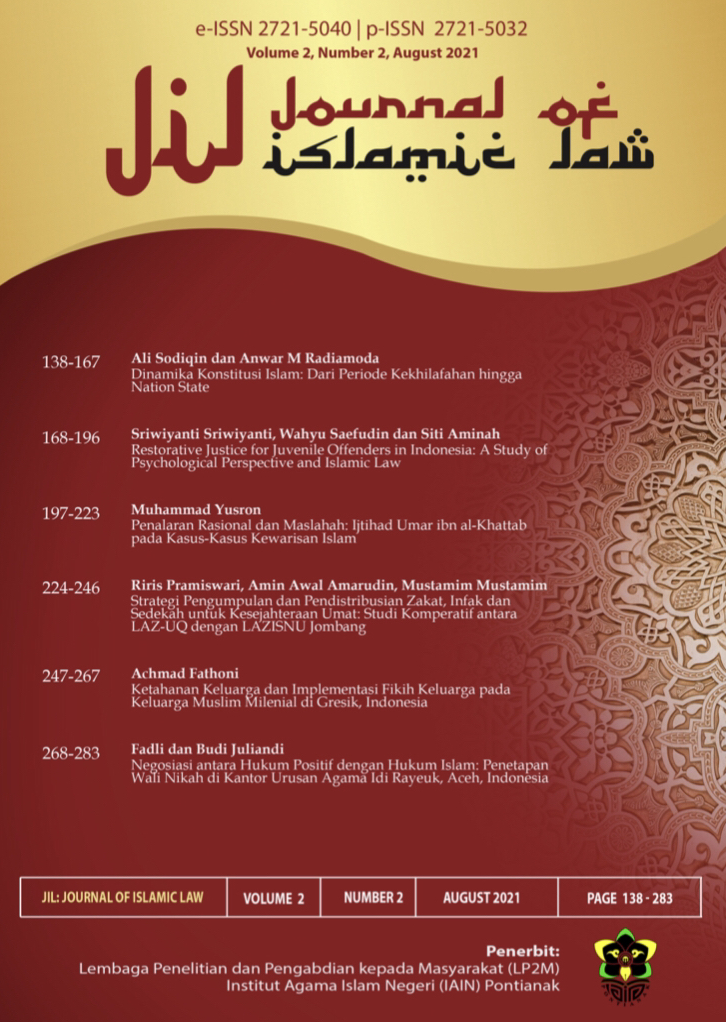The Dynamics of Islamic Constitution: From the Khilāfah Period to the Nation-State
Dinamika Konstitusi Islam: Dari Periode Kekhilafahan hingga Nation State
DOI:
https://doi.org/10.24260/jil.v2i2.241Keywords:
Islamic Constitution, Caliphate, Nation-State, PluralismAbstract
The debate about the form of the state in Islam took place among Muslim intellectuals. Normatively, the unclear arguments about the relationship between religion and the state in Islamic sources are the leading cause. Historically, there are various forms of Islamic state practiced by Muslims from classical to modern times. This article discusses the dynamics of the constitution practiced by Islamic countries throughout history, from the Prophet to the present. Why is the Islamic constitution different in its arrangement and application in the history of Islamic governance? What are the factors that influence that diversity? The questions discussed in this article use a historical approach to mapping continuity and change in the Islamic constitution. In the period of the caliphate, there was no written constitution as the basis for statehood. The caliph is the constitution itself because of its absolute power. During the nation-state period, there were differences in the placement of Islam as a religious state, shariah as the only source of law, and judicial institutions that sought to adjust the compatibility of the shariah. Four factors cause the diversity of constitution in Islamic countries; the absence of specific rules about state administration in Islamic sources, the centralist and absolute power of caliph, the participation in the development of traditions that developed at that time, and the influence of western countries through colonialism in the Islamic world.
References
’Irfaan, Santosa. “Al-Khilafah Menurut Al-Mawardy.” Jurnal Khatulistiwa-Journal of Islamic Studies 3, no. 2 (2013): 121–31.
Adibah, Ida Zahara. “Islam , Muslim, dan Perilaku Politik (Konsep Nation-State di Dunia Islam Kontemporer).” Madaniyah 4, no. 1 (2016): 1–19. https://journal.stitpemalang.ac.id/index.php/madaniyah/article/view/51.
Akbar, Idil. “Khilafah Islamiyah: Antara Konsep dan Realitas Kenegaraan (Republik Islam Iran dan Kerajaan Islam Arab Saudi).” Journal of Government and Civil Society 1, no. 1 (2018): 95. https://doi.org/10.31000/jgcs.v1i1.265.
Al-Ghazali, Abu Hamid Muhammad bin Muhammad. Al Iqtishad Fil I’tiqad. Kairo: Maktabah al Jund, 1972.
Al-Mubarakfury, Shafiyyur-rahman. Sirah Nabawiyah. Edited by Yasir Maqosid. Jakarta: Pustaka Al Kausar, 2008.
Ardiansyah, Irfan. “Pergeseran dari Sistem Khilafah ke Nation-State Dunia Islam.” UIR Law Review 1, no. 2 (2017): 201–12. https://doi.org/10.25299/uirlrev.2017.1.02.752.
“Constitution of Malaysia.” Diakses pada 22 Februari 2021. https://www.concourt.am/armenian/legal_resources/world_constitutions/constit/malaysia/malays-e.htm.
Diab, Ashadi L. “Hukum Islam dan Ketatanegaraan.” Al- ’Adl 9, no. 2 (2016): 143–57.
Djazuli, A. Fiqh Siyāsah‚ Implimentasi Kemaslahatan Umat dalam Rambu-Rambu Syariah. Jakarta: Kencana, 2004.
Fabian Fadhly. “Islam dan Konstitusi Indonesia 1945.” Thaqafiyyat 18, no. 1 (2017): 86–106.
Ghazali, Muhammad al. Fiqh Al Sirah. Kairo: Dar al-Dakwah, 1963.
Ghofur, Abd. “Islam dan Politik di Brunei Darussalam (Suatu Tinjauan Sosio-Historis).” TOLERANSI: Media Komunikasi Umat Beragama 7, no. 1 (2015): 53–69.
Gibb, Hamilton A.R. Muhammadanism, A Historical Survey. London: University Press, 1949.
Gunawan, Dadang, Halkis, dan Hindro Muriadi. “Melayu Islam Beraja (MIB) sebagai Instrumen Pencegahan Insurjensi di Brunei Darussalam.” Jurnal Prodi Perang Asimetris 4, no. 1 (2018): 93–112.
Harun. “Konstitusi dalam Perspektif Hukum Islam.” Suhuf 24, no. 1 (2012): 26–38.
Hitti, Philip K. The History of the Arabs. Edited by R. Cecep Lukman Yasin. Jakarta: PT. Serambi Ilmu Semesta, 2005.
IDEA, International. “Egypt’s Constitution of 2014.” constituteproject.org, 2014. ttps://www.constituteproject.org/constitution/Egypt_2014.pdf.
Iqbal, Muhammad. Fiqh Siyāsah Kontekstualisasi Doktrin Politik Islam. Jakarta: Gaya Media Pratama, 2001.
Jailani, Imam Amrusi. “Piagam Madinah: Landasan Filosofis Konstitusi Negara Demokratis.” Al-Daulah : Jurnal Hukum dan Perundangan Islam 6, no. 2 (2016): 269–95. http://jurnalfsh.uinsby.ac.id/index.php/aldaulah/article/view/114%0Ahttp://jurnalfsh.uinsby.ac.id/index.php/aldaulah/article/download/114/pdf_10.
Kadir, Abd. “Syiah dan Politik: Studi Republik Islam Iran.” Jurnal Politik Profetik 5, no. 1 (2015): 1–15.
Karomah, Atu. “Konstitusi dalam Islam.” Jurnal Hukum Dan Politik Al-Qisthas 7, no. 1 (2016): 67–79.
Kirisci, Kemal, dan Ilke Toygür. “Turkey’s New Presidential System and a Changing West: Implications for Turkish Foreign Policy and Turkey-West Relations,” 2019.
Kurniawan. “Demokrasi dan Konstitusionalisme Hukum Islam Indonesia.” Kanun Jurnal Ilmu Hukum XIII, no. 55 (2011): 149–62.
Ma’shum. “Islam dan Pencarian Identitas Politik (Ambiguitas Sistem Khilafah Dalam Institusi Politik Islam).” Asy-Syir’ah Jurnal Ilmu Syari’ah Dan Hukum 47, no. 2 (2013): 483–517.
Manan, Abdul. Politik Hukum, Studi Perbandingan dalam Praktik Ketatanegaraan Islam dan Sistem Hukum Barat. Cet. 1. Jakarta: Prenadamedia Group, 2016.
Maryam, Siti. Sejarah Peradaban Islam, dari Masa Klasik hingga Modern. Yogyakarta: LESFI, 2009.
Mawardi, Al. Al Ahkam Al Sulthaniyah. Beirut: Dar al Fikr, n.d.
Max Planck Institute, Oxford University Press, Inc. “Algeria’s Constitution of 1989, Reinstated in 1996, with Amendments through 2008.” constituteproject.org, n.d. https://www.constituteproject.org/constitution/Algeria_2008.pdf.
Musa, Abdul Samat. “Constitutional Law: An Overview of the Islamic Approach and Its Contemporary Relevance.” Advances in Social Science, Education and Humanities Research 192 (2018).
Mustaqim, Muhammad, dan Muhammad Miftah. “Tantangan Negara-Bansa (Nation-State) dalam Menghadapi Fundamentalisme Islam.” ADDIN 9, no. 1 (2015): 85–106.
Naeem, Naseef. “The Influence of Religious Clauses on Constitutional Law in Countries With an Islamic Character.” In Islam and the Rule of Law: Between Sharia and Secularization, edited by Birgit Krawietz Helmut Reifeld. Berlin: Konrad-Adenauer-Stiftung, 2008.
Nasaruddin, Nasaruddin. “Pemikiran Islam tentang Hubungan Negara dengan Agama.” HUNAFA: Jurnal Studia Islamika 6, no. 2 (2009): 205–18. https://doi.org/10.24239/jsi.v6i2.134.205-218.
Nasution, Harun. Pembaharuan dalam Islam. Jakarta: Bulan Bintang, 1976.
Ozbudun, Ergun. “Desain Konstitusi di Negara Islam: Catatan Perbandingan Tentang Turki, Mesir, dan Tunisia.” In Dialog ISMC Tahun 2015-2016, 1–33, 2016.
Pakistan, National Assembly of. “The Constitution of The Islamic Republic of Pakistan.” Islamabad. Diakses pada 22 Februari 2021. http://www.na.gov.pk/uploads/documents/1549886415_632.pdf.
Piscatori, P James. Islam in a World of Nation-states. New York: Cambridge University Press, 1994.
Rais, Muhammad Dhiauddi. Teori Politik Islam. Jakarta: Gema Insani Press, 2001.
Rohim, Nur. “Kedudukan Konstitusi dalam Praktik Ketatanegaraan Saudi Arabia.” Tahkim IX, no. 2 (2013): 95–111.
Ruchti, Jefri J. “Morocco’s Constitution of 2011.” constituteproject.org, 2012. https://www.constituteproject.org/constitution/Morocco_2011.pdf.
Siregar, Syahrudin. “Khilafah Islam dalam Perspektif Sejarah Pemikiran Ali Abdul Raziq.” JUSPI (Jurnal Sejarah Peradaban Islam) 2, no. 1 (2018): 124–37. https://doi.org/10.30829/j.v2i1.1794.
Storm, Lise. Democratization in Morocco, The Political Elite and Struggles for Power in the Post-Independence State. New York: Routledge, 2007.
Sulthon. “Metodologi dan Teoretisasi Politik Islam.” Al-Daulah: Jurnal Hukum Dan Perundangan Islam 9, no. 1 (2019): 25–51. https://doi.org/10.15642/ad.2019.9.1.25-51.
Suparto. “Pemisahan Kekuasaan, Konstitusi dan Kekuasaan Kehakiman yang Independen Menurut Islam.” Jurnal Selat 4, no. 115–129 (2016).
Syadzali, Munawir. Islam dan Tata Negara. Jakarta: UI Press, 1990.
Syarif, Nurrohman. “Syariat Islam dalam Perspektif Negara Hukum Berdasar Pancasila.” Pandecta: Research Law Journal 11, no. 2 (2017): 160–73. https://doi.org/10.15294/pandecta.v11i2.7829.
Talib, Naimah S. “Brunei Darussalam: Kesultanan Absolut dan Negara Modern.” Kyoto Review of Southeast Asia 13, no. 13 (2013): 1–9. https://kyotoreview.org/wp-content/uploads/Naimah-Talib-Bahasa.pdf.
Thaib, Lukman. Politik Menurut Perspektif Islam. Selangor Darul Ehsan: (Synergymate Sdn. Bhd., 1998.
“The Constitution of The Hashemite Kingdom of Jordan.” Diakses pada 22 Februari 2021. https://www.refworld.org/pdfid/3ae6b53310.pdf.
UNDP and reviewed by International IDEA. “Tunisia’s Constitution of 2014.” constituteproject.org. Diakses pada 22 Februari 2021. https://www.constituteproject.org/constitution/Tunisia_2014.pdf.
Wasino, dan Endah Sri Hartatik. , Metode Penelitian Sejarah: Dari Riset hingga Penulisan. Yogyakarta: Magnum Pustaka Utama, 2018.
Wijaya, Abdi. “Sejarah Kedudukan Hukum Islam dalam Konstitusi-Konstitusi Indonesia (Sistem Ketatanegaraan di Indonesia).” Al Daulah : Jurnal Hukum Pidana Dan Ketatanegaraan 7, no. 2 (2018): 234–48. https://doi.org/10.24252/ad.v7i2.7020.
Yegen, O. “Constitutional Changes under the AKP Government of Turkey”.” Bij De Buren 70 (2017).
Zulkarnain. “Konsep Al-Imamah dalam Perspektif Syi`ah.” Jurnal TAPIs 7, no. 13 (2011): 46–60.
Downloads
Published
How to Cite
Issue
Section
License
Copyright (c) 2021 Ali Sodiqin, Anwar M Radiamoda

This work is licensed under a Creative Commons Attribution-NonCommercial 4.0 International License.










